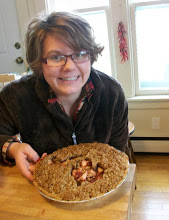
Last night I arrived back from a three day trip to the Volta Region. I was sent out to observe the Heifer Project International (HPI), an organization that seeks to provide communities with "living loans" in order to create economic community development in under-deserved areas. The organization that I am interning with, the Development Solutions Centre, is contracted out by HPI and is responsible for the implementation and on-the-ground success of the HPI projects in Ghana. My assignment consisted of performing a needs assessment on the sanitation and hygiene of schools surrounding the community of Dorveme.
On Tuesday, I visited three schools in Dorveme and Tsiame (pronounced "chee-ya-may"). Of the three schools, one was a community kindergarten, and the two other were "publicly" funded Catholic and Evangelical Presbyterian Primary schools (Grades one to six). I conducted interviews with the headmasters and teachers to gain information regarding the sanitation programs being taught throughout the school year. Though I was originally sent to "create" a sanitation program, upon arriving I found that all schools have addressed sanitation quite adequately. It is not that the school teachers and students were unaware of the importance of sanitation, but rather that the sanitation facilities were lacking or else unavailable.
For example, the community kindergarten in Dorveme taught children to was their hands after using the toilet but there weren't sinks, running water and soap available for the children to accomplish such tasks. Alas, the latrine the student had been using broke and the teacher did not have the funds available to purchase a new one.
Similarly at another school, Tsiame E.P. Primary, there was an extensive sanitation program in place with a sanitation teacher that was scheduled to teach three sanitation classes per week for every grade. The sanitation teacher stresses the need to clean up the toilets after use BUT as I found out, there are 10 toilets available for approximately 400 school children. In addition, these toilets were installed and have been used for ten years. Now, it doesn't take a PH.D. candidate to understand that the sanitation of the toilets is not going to be on par.
So, my task is now to perform a needs assessment for the Dorveme-Tsiame school district to try and figure out what they need, how much the costs will be and possible funding bodies. In addition, I must take into account the sustainability of the sanitation program and how funds will be made available in the future should another latrine break and is unable to be fixed or replaced. Resources. People require resources.
I find that it's continually interesting to ask questions such as why isn't Ghana able to afford to subsidize its public school system? These questions are related to my research project regarding the debate over water privatization. Why isn't Ghana able to be financially independent? What does "independence" mean if Ghana formally "achieved" its independence 53 years ago yet it still cannot afford basic social services? These are some of the larger questions that I think about in regards to my experience as an intern and student.
During our time out in the Volta Region, we (my colleague and I) explored the grasscutter, goat, sheep and crop farms. We were also able to see the "passing of the gift" in which one farmer will give another farmer the offspring of his or her animals. The HPI seeks to ensure long-term economic sustainability through its living loans program, so it was interesting to see exactly how it is able to ensure such measures.
In addition to our time, we were once again introduced to new sights, smells, tastes and sounds. The Volta Region is distinctly different from the Greater Accra Region. In Accra, the Akans speak Twi while in the Volta, the Ewe people (pronounced eh-whey) speak several different dialects of Ewe. The Ewe also have a very different variety of dishes-- Abolo, jooey (pronounced joe-whey), yakey yake (a.k.a yackson), akble, and stews containing anchovies (a.k.a. "Keta" School boys), herring, tilapia, crab, sole, tuna, and other fresh fishes from the surrounding lagoon and ocean. It's a very aesthetically beautiful area, surrounded by beaches and a nice ocean sea breeze which really feels great in the mid-afternoon 100 degree weather :)


No comments:
Post a Comment